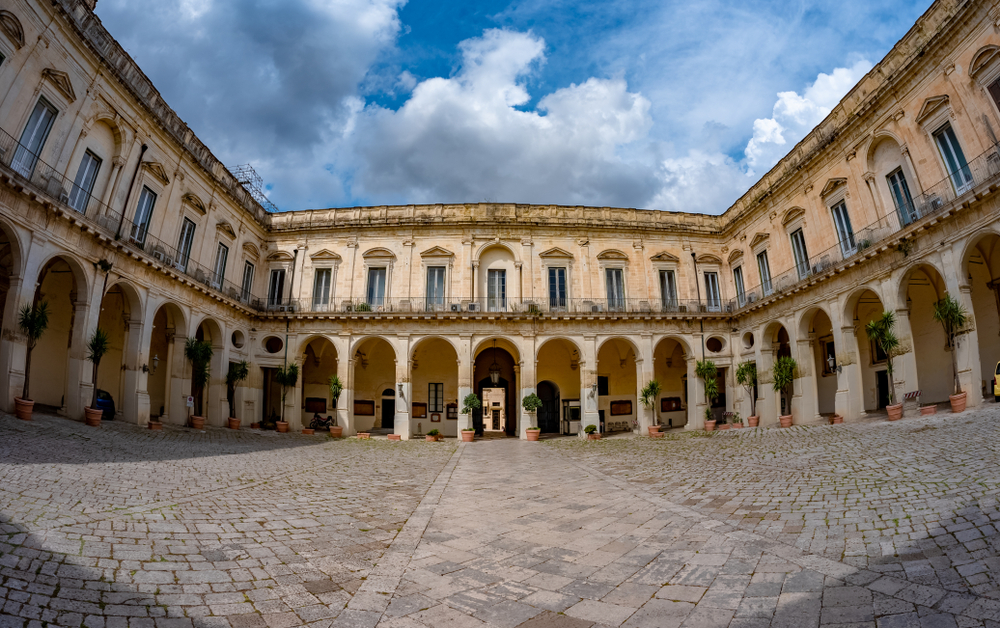A Guide to Lecce, Puglia
Situated within the region of Puglia at Italy’s southern tip, Lecce is one of Italy’s lesser-known cities. As a result, it often avoids the crowds seen in many bigger Italian cities during the peak summer months, without compromising on authenticity. It is well-known for its Baroque style of architecture and its quintessential Italian streets. In fact, often referred to as Puglia’s ‘Baroque jewel’, Lecce has a rather different feel to many of the towns in Puglia. However, the history of Lecce certainly goes much further back than the 16th century period of Spanish rule under which the Baroque architecture flourished. This guide to Lecce should leave you feeling ready to enjoy this fabulous city and all it has to offer.
What to see and do in Lecce
There is so much to see and do, that we’ve had to try hard to pack it into this guide to Lecce. We recommend walking through to the historical centre of the city as soon as you arrive. Enter the city through one of the old gates that provide access in and out of the ancient walled city. Called the Lecce Portas, there are three gates left today, marking the boundary between the old city and new city.

The main gate is the Porta Napoli dating back to 1548 and so-called as it was constructed for a state visit from Charles V. It is modelled on a Roman triumphal arch. On the same side of the city as this gate, there is the Porta Rudiae which is the oldest of the gates. This is topped by statues of saints and is very close to a small market selling fresh fruit, vegetables and other foodstuffs. And last but not least is the Porta San Biagio on the other side of the city. This is probably the least used but worth a visit nonetheless. Once inside any of these gates, there is very little traffic so it is a real pleasure to wander around.
Head toward the Roman Amphitheatre in the Piazza Sant’ Oronzo. This is one of the city’s main attractions. Built almost two millennia ago out of the iconic yellow limestone commonly found in southern Italy, it is estimated that up to 15,000 – 20,000 spectators once enjoyed the many infamous gladiator battles held in the arena.

While only a portion of the amphitheatre was excavated when re-discovered in the early 20th Century, the arena still often hosts events and performances open to the public. Most of the amphitheatre can be viewed from the street, however, for those hoping for a closer look at the historic site, tickets to enter the arena are available for just a few euros each. Incidentally, whilst here you may want to pop into the Tourist Information Office which is also situated in the piazza. And the piazza is also home to the column of Sant’ Oronzo (Lecce’s patron saint) along with a rather unusual 20 metre high bronze clock – the Orologio delle Meraviglie – which was designed in 1955 and sits on the exterior wall of the Bank of Naples (Banco di Napoli).
Lecce’s rich Roman heritage extends further than its central amphitheatre. Look carefully within its streets to discover the remains of a 2nd century Roman Theatre (Teatro Romano). This would once have seated up to 4000 people. The best views are from the Via Arte della Cartapesta.
When considering what to see and do in Lecce remember the city is also home to many museums, all of which can be accessed for just five euros per person through the official Lecce tourism website. Our personal favourite, which we’ve chosen for this guide to Lecce, is Museo Faggiano, which was discovered by accident in 2001 when the homeowner above attempted to fix his outdated plumbing and needed to break up the floor into order to deal with it. Below he discovered incredible archaeological remains dating back 2500 years including an array of underground cisterns, secret passageways and tombs. Dating back to pre Roman times and once a Knights Templar house and then home to a convent of Franciscan nuns, today it remains the only independent museum in Lecce. The museum is conveniently located within the heart of the city, and its contents can easily be viewed in less than an hour, making it the perfect cultural stop-off on a short trip.
Another museum well worth a visit is the Jewish Museum situated in the Palazzo Taurino. There was a thriving Jewish community in Lecce until they were expelled in 1540, after which most of the Jewish buildings were destroyed and replaced with Baroque buildings. The museum provides an important insight into the Jewish history here including covering the more recent past after WWII when Jewish refugees were placed in camps in the Salento region.
Next on your trip to Lecce should be a visit to Lecce’s cathedral which is nestled in the corner of the Piazza del Duomo. Defininitely worth putting on your list of what to see and do in Lecce.

The Duomo was actually built as far back as 1144 but the 70 metre high bell tower was added much later in the mid 17th century. The tower is the work of Giuseppe Zimbalo, a talented architect who also worked on many of the other buildings of Lecce’s Baroque period. The cathedral is free to visit and we think it’s especially breathtaking when it’s lit up at night. Incidentally, should you wish to do so, it is possible to take the elevator up to the top of the bell tower to enjoy a view over Lecce.

There are a number of other churches worth seeing in Lecce. There are too many to mention here but some of the most impressive are the Churches of San Givanni Battista, Santa Chiara and San Matteo. All are ornately decorated in the 17th century Baroque style.
But no visit to Lecce would be complete without visiting the beautiful Basilica di Santa Croce, also located in the heart of the historic centre of Lecce. As already mentioned, the city is known for its distinctive Baroque style of architecture and the basilica, having taken almost 150 years to construct, is often regarded as the finest example of this style in Italy. Certainly its facade is arguably the most intricate Baroque facade anywhere in Italy. This was actually in part the work of Zimbolo’s grandfather! The interior of the church is equally impressive as its exterior, containing no less than seventeen altars and boasting a carved wooden ceiling similar in style to that seen inside the Pantheon in Rome.
Sitting adjacent to the basilica is the Palazzo dei Celestini. This is another of Zimbalo’s masterpieces. Once an old convent of the Celestine order, it is now the seat of local government. It’s a beautiful building surrounded by 24 arches sat atop 44 columns and boasting a rather elegant facade. Take a walk through the central courtyard of the palazzo and out the other side to discover Lecce’s main park – the Villa Comunale – ideal for a short walk or to just sit and relax for a while.

All these sights can be enjoyed on a walking tour of Lecce, a bike tour of Lecce or even a rickshaw tour of Lecce for those that prefer something that requires a little less effort. Opting for any of these group tours will give you a much greater insight into the city of Lecce. Or, if you a guide all to yourself, opt for a private guided tour of Lecce instead.
And then, after a long day of travel and sightseeing in an Italian city, there’s nothing quite like a relaxing aperitif. Like most other Italian cities, the city of Lecce is home to hundreds of bars and cafes serving locals and tourists alike. They can be the perfect way to spend a few hours in the late afternoon and early evening before heading out for dinner. You’ll notice that this is the time that the locals come out to enjoy their passeggiata, bringing life into what were just before the sleepy streets streets of Lecce. Head to the Via Vittorio Emanuele II between the Piazza del Duomo and the Piazza Sant’ Oronzo if you want to be at the centre of the action. Puglia’s hot climate produces bold and distinctive wines which are often high in acidity – a refreshing glass of one of the regions best-known varieties – Primitivo or Saline Salentino – is a must at aperitivo hour for anyone visiting the area.
And, after an aperitif, we recommend visiting one of the many family-run trattorias that line the streets of Lecce. As is the case with almost all Italian cities, Lecce’s culinary scene is rich and diverse, offering delicious food that reflects the city’s affluent past. As is the case with many Italian cities, the best food can be found in the side streets away from the main attractions, where prices are not inflated for tourists. Much of Lecce’s food scene is centred around seafood thanks to its proximity to the Mediterranean. Scapece is arguably the city’s most famous dish and consists of small fried pupiddi fish which have been marinated in vinegar and saffron. The dish is commonly made during the city’s most famous festival held in late August every year when the city celebrates its Patron Saint, Sant’ Oronzo.
Incidentally, if you want to learn more about the food of this region, then you won’t do better than attending a cookery class in Lecce. One of our favourites is Cooking Experience Lecce under the tutelage of the lovely Gianna Greco. Alternatively, opt for a street food tour of Lecce or even a gelato making workshop.
And finally, if you’re a bit of a shopaholic, you should also find plenty in Lecce to keep you occupied. Probably the best shopping streets are the Via Palmieri, the Via Vittorio Emanuele II and the Via Salvatore Trinchese.
In short, whether you’re planning to visit for a weekend, or want to spend longer in Lecce, with its convenient location, attractive climate and rich history, there is plenty to keep any visitor to this iconic city occupied.
Events in Lecce
Already mentioned is Lecce’s annual celebration of its patron saint, Sant’ Oronzo. He is celebrated between 24 and 26 August each year.
Lecce also hosts regular markets throughout the year. These include the smaller Mercatino Porta Rudiae, just behind the gates of the same name. This is ideal if you’re looking to purchase produce and foodstuffs. This is open every morning. Or, for a larger market, head outside the centre of Lecce towards its stadium on Mondays and Fridays where you will discover a much larger market which, along with foodstuffs, also sells clothes and leather goods.
Where to stay in Lecce
Accommodation in Lecce doesn’t get much better that this Lecce villa rental. Villa Museo is situated just 8 km from the heart of Lecce in the small and rather charming village of Lequile. It can comfortably sleep up to 10 guests in five beautifully decorated bedrooms.

What is the best time to visit Lecce
Lecce’s geographical location in the very south of Italy offers warm weather long after the Summer months have ended. Our recommendation is therefore to spend a weekend in the city during the Spring or Autumn months, where the weather is better-suited to sightseeing compared to the high temperatures seen across July and August.
That said, if you are visiting in the height of the Summer, don’t worry. Just be aware that you’ll find the locals enjoy a siesta between 2 pm and 5 pm each day so make sure you ideally start your visit after then. Then you can be sure to find that the streets will have a real buzz to them, lined with independent stores, hip bars, cafes and restaurants. And if you need to cool down, don’t miss the chance to sit and enjoy one of the city’s speciality coffees – caffe in ghiaccio con latte di mandorla (espresso with ice and almond milk) – which is incredibly refreshing – perhaps one of the best bits of advice in this guide to Lecce!
How to get to Lecce
By air: After flying into Brindisi Airport, the city of Lecce is just a short 45 minute drive away. Alternatively, Bari airport is a couple of hours away by car.
By train: Lecce has a train station. It is situated at the Piazzale Oronzo Massari, within walking distance of the historic centre of the city.
By car: Parking is restricted within the historic centre so those coming by car will need to park outside the main gates of the city in the newer part of the town.
We hope ypu have enjoyed this guide to Lecce and for those still asking, ‘Is Lecce worth visiting?’ I think we can all agree the answer is an outstanding yes!


